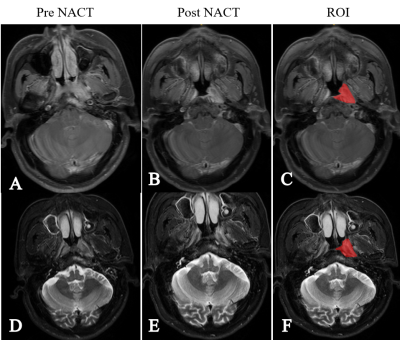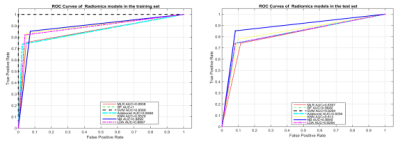0934
Prediction of prognosis of nasopharyngeal carcinoma after neoadjuvant chemotherapy based on radiomics and multimodal machine learning
Chunmiao Hu1, Zhijian Hu2, Li Chen3, DeChun Zheng4, Yunbin Chen4, Xisheng Cao4, and Tao Lu4
1Radiology, Fujian Medical University Cancer Hospital, Fujian Cancer Hospital, Fuzhou, China, 2School of Public Health, School of Public Health, Fujian Medical University, Fuzhou Fujian 350122, China, Fuzhou Fujian, China, 3School of Arts and Sciences, School of Arts and Sciences, Fujian Medical University, Fuzhou Fujian 350122, China, Fuzhou Fujian, China, 4Fujian Medical University Cancer Hospital, Fujian Cancer Hospital, Fuzhou, China
1Radiology, Fujian Medical University Cancer Hospital, Fujian Cancer Hospital, Fuzhou, China, 2School of Public Health, School of Public Health, Fujian Medical University, Fuzhou Fujian 350122, China, Fuzhou Fujian, China, 3School of Arts and Sciences, School of Arts and Sciences, Fujian Medical University, Fuzhou Fujian 350122, China, Fuzhou Fujian, China, 4Fujian Medical University Cancer Hospital, Fujian Cancer Hospital, Fuzhou, China
Synopsis
This study is the first to adopt post-NACT MR radiomics to predict the recurrence of locally advanced NPC (stages III and IVa).
Synopsis
This study is the first to adopt post-NACT MR radiomics to predict the recurrence of locally advanced NPC (stages III and IVa). Altogether, 15 features were screened from the T2WI sequence, and 20 features related to the 5-year recurrence of NPC were screened from the T1WI+C sequence.Purpose
To explore the value of magnetic resonance radiomics and multimodal machine learning classifiers after neoadjuvant chemotherapy (NACT) for predicting the long-term recurrence of nasopharyngeal carcinoma (NPC).Materials and Methods
Altogether, 271 consecutive patients with NPC after NACT were selected (183 without recurrence within 5 years and 88 with recurrence). All patients were randomly divided into the training (n=185) and test sets (n=86). The regions of interest were delineated on the axial T2-weighted imaging (T2WI) and T1-weighted imaging (T1WI) enhanced sequences; the LASSO method was used for dimensionality reduction to construct the final model. Seven machine learning classifiers were analyzed. The area under the curve (AUC) values were used to evaluate the efficacy to predict 5-year recurrence.Results
The AUC values of diverse T2WI sequence-based machine learning classifiers for predicting NPC recurrence ranged from 0.87 to 1. Random forest (RF) achieved an AUC=1, with an accuracy, specificity, and sensitivity reaching 100%. K-nearest neighbor had the second best performance (AUC=0.92; accuracy, 93%; sensitivity, 89%; and specificity, 95%). RF had the highest prediction performance. The AUC values of diverse machine learning classifiers in the test set ranged from 0.79 to 0.88. On the T1WI+C sequence, the AUC values of diverse machine learning classifiers were between 0.85 and 1. The AUC values of diverse machine learning methods in the test set were between 0.81 and 0.88.Conclusion
After NACT, the T2WI and T1WI enhanced sequence-based radiomics and multimodal machine learning accurately predicted long-term recurrence.Keywords
Nasopharyngeal carcinoma; Magnetic resonance imaging; Neoadjuvant chemotherapy; Machine learning; RecurrenceAcknowledgements
The authors would like to acknowledge the contribution of information Ms LiChen and Mr ZhijianHu ( Fujian Medical University) for their valuable assistance with the data processing. We would like to thank the following colleagues: Chunmiao Hu, DeChun Zheng, Xisheng Cao, LuTao for participating to data collection. Authors thank GE provided the AK software to us free of charge. There is no conflict of interest.References
noFigures

Magnetic resonance images of male patients at 45 years of age with T3N1M0 and no recurrence for 5 years. (A) Pretreatment T1-weighted imaging (T1WI)+C image, (B) posttreatment T1WI+C image, (C) region of interest (ROI) on the pretreatment T1WI+C image, (D) pretreatment T2-weighted imaging (T2WI) image, (E) posttreatment T2WI image, and (F) ROI on the pretreatment T2WI image.

Receiver operating characteristic curve for the training and test set of each radiomics classification model in T2-weighted imaging sequence

Receiver operating characteristic curves for the training and test set of diverse radiomics classification models in the T1-weighted imaging enhanced sequence
DOI: https://doi.org/10.58530/2022/0934